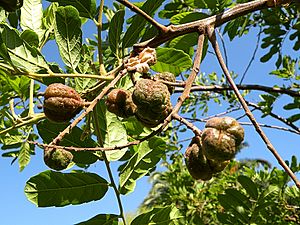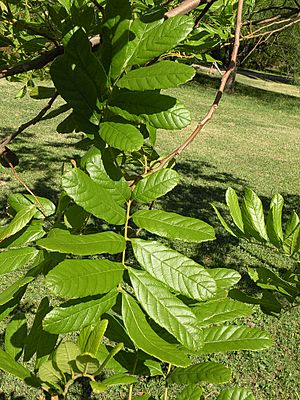Cupania vernalis facts for kids
Quick facts for kids Cupania vernalis |
|
|---|---|
 |
|
| Camboatá (Cupania vernalis) | |
| Scientific classification | |
| Genus: |
Cupania
|
| Species: |
vernalis
|
Cupania vernalis is a fascinating plant species. It is often known by its common name, Camboatá. This plant belongs to the Cupania genus, which is a group of trees and shrubs. You can find Camboatá growing naturally in various parts of South America. It is especially common in countries like Brazil, Argentina, and Paraguay. This plant is valued for its beautiful appearance and its role in local ecosystems.
Contents
What is Camboatá?
Camboatá, or Cupania vernalis, is a type of tree. It is part of the Sapindaceae family, which also includes plants like lychee and maple. This family is known for its diverse range of trees and shrubs. Camboatá is a deciduous tree, meaning it sheds its leaves during certain seasons. It can grow quite tall, reaching heights that make it stand out in its natural habitat.
Where Does Camboatá Grow?
Camboatá trees are native to the subtropical and tropical regions of South America. They thrive in areas with plenty of sunshine and moderate rainfall. You can often find them in forests, along riverbanks, and in open woodlands. They are well-adapted to different soil types. This helps them grow in various environments across their native range. Their ability to adapt makes them a resilient species.
What Does Camboatá Look Like?
The Camboatá tree has several distinct features. Its trunk is usually straight and can be covered in a rough bark. The leaves are compound, meaning each leaf is made up of several smaller leaflets. These leaflets are typically green and have a glossy texture.
Flowers and Fruits
Camboatá produces small, yellowish-white flowers. These flowers often grow in clusters. They appear in the spring, which is why the species name is "vernalis" (meaning "of spring"). After the flowers bloom, the tree produces interesting fruits. These fruits are usually small capsules that split open when ripe. Inside, they contain dark, shiny seeds. These seeds are often covered by a bright, fleshy layer called an aril.
How is Camboatá Used?
Camboatá has several uses, especially in the regions where it grows naturally. Its wood is known for being strong and durable. Because of this, it is sometimes used in construction or for making furniture. The tree's attractive appearance also makes it a good choice for landscaping. It can be planted in parks and gardens for its shade and beauty.
Importance for Wildlife
The fruits of the Camboatá tree are an important food source for local wildlife. Many bird species and small mammals enjoy eating the seeds. This helps the tree spread its seeds to new areas. The tree also provides shelter for various animals. Its presence supports the biodiversity of its ecosystem.
Interesting Facts About Camboatá
- The name "Camboatá" comes from indigenous languages in South America.
- The tree's ability to grow in different conditions makes it important for reforestation projects.
- Its spring flowering period is a key event in the local ecosystem.
- The bright aril around its seeds is very appealing to fruit-eating animals.
See also
 In Spanish: Camboatá para niños
In Spanish: Camboatá para niños


